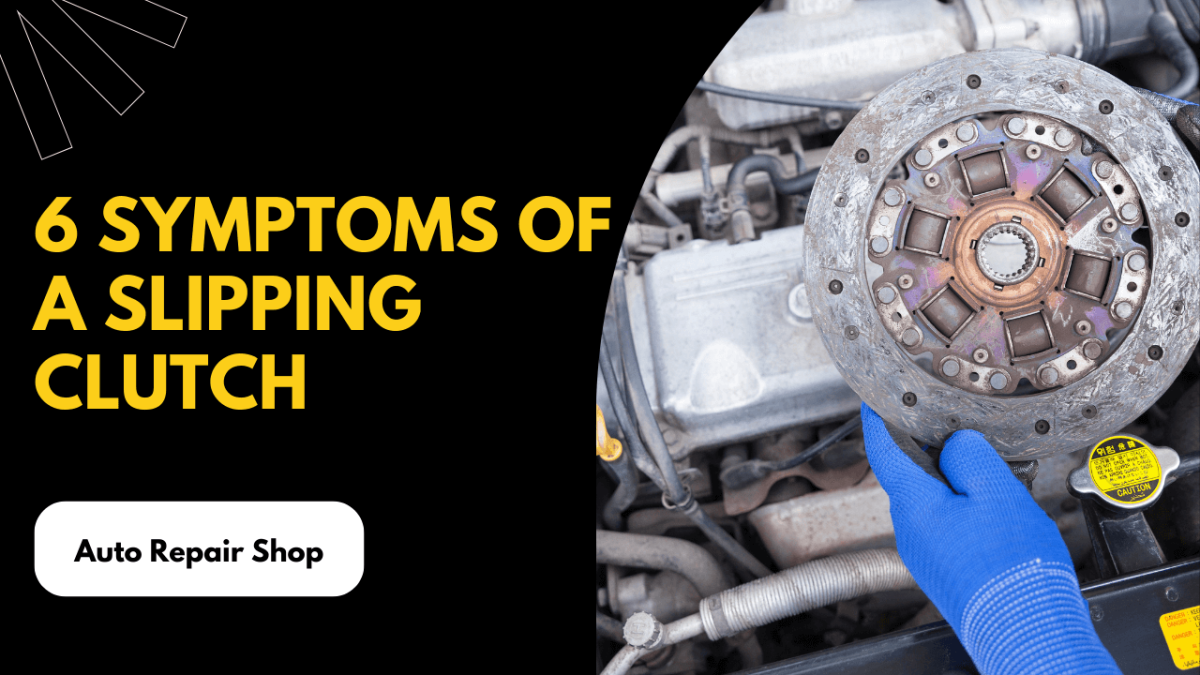September 08, 2022
6 symptoms of a slipping clutch that are worth paying attention to
Hey, do you want to know what are the Symptoms of slipping a clutch? If yes. Then read this blog till the end.
Do you recall your first time getting behind the wheel and beginning your driving lessons? You must have first learned to depress the leftmost pedal and turn the keys. This pedal is the clutch. To propel your car ahead after the engine has started, you must push it once more to shift into first gear. But carefully synchronize the clutch and accelerator.
Now that you have a basic understanding of driving, you can see why a clutch is one of a car’s most essential parts. But what if your clutch slips out of nowhere, or you’re suddenly experiencing difficulties using it even though it worked flawlessly just a short while ago? Don’t worry, here I have described 6 symptoms of a slipping clutch and everything that there is to know about clutch slipping and what to do if you find yourself in such a situation. To begin with, let’s understand how a perfectly operating clutch works.
The clutch, or more precisely the clutch assembly, is a group of parts that come together to accomplish one straightforward task. When the clutch pedal is fully depressed, the engine disconnects from the transmission and consequently, when you release the clutch, the engine gradually gets reconnected to the transmission.
Technically, the clutch isolates the wheels from the engine. This enables you to stop your car while the engine is still operating and change gears. It is a crucial component of your car because you can’t drive safely without it. If functioning properly, a clutch has three main components:
- Clutch Plate
- Pressure Plate
- Flywheel
Together, all three components enable seamless gear switching. However, replacing a clutch results in additional driving issues.
The lifespan of a clutch can range from 100,000 to 300,000 kilometers. The number of kilometers your clutch can sustain solely depends on the road and your driving style. There is no method of predicting a clutch’s life with accuracy.
Let us now understand what a slipping clutch is
What is a Slipping Clutch?
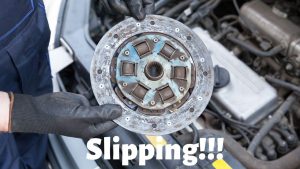
Your car is in gear, the clutch pedal is fully released, and you press the accelerator pedal. Have you noticed an unexpected increase in the speed of your car that happens without any accompanying acceleration? This is a clutch slip. Moreover, it will be evident if you try to sprint up a steep hill.
The slipping clutch issue might occur when there is low friction in the clutch, causing the engine speed to rise without a matching rise in road speed. Clutch slip may also result from excessive oil on the clutch or general wear and tear.
Technically, clutch slipping occurs when your clutch disengages, and no power is being transferred to the wheels to drive or propel the car forward. With a manual transmission vehicle, a slipping clutch is a frequently occurring event that will happen at some point. This is because of normal wear and tear, poor driving practices, and road conditions. The clutch will eventually fail. Therefore, getting your clutch checked every 60,000 miles is advisable.
Simply put, clutch slipping is when your clutch engages and disengages without delivering any power to the wheels, preventing the automobile from moving forward. When the clutch slips, no power is transferred to the car’s wheels as it engages and disengages. The mentioned transfer of power does not take place. It could easily happen sooner or later if you operate a manual transmission vehicle.
When inspecting the clutch, a competent mechanic will be able to identify any such issues and fix them.
Every 60,000 to 100,000 miles, a clutch needs a complete and appropriate inspection; however, your annual service will likely include at least a cursory examination. We will now explain to you some of the commonly known symptoms of a slipping clutch in the sections that follow:
Six symptoms of a slipping clutch
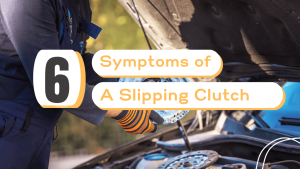
Your clutch may be about to fail if you’ve noticed any pedal sticking or if your car is making unusual noises or grumbling sounds. These sounds could be a sign of a slipping clutch. There are many symptoms of a slipping clutch but first, let’s see what happens during clutch slippage.
The friction material is present on both sides of the clutch disc. One part of this material touches the flywheel on the engine, while the other touches the friction surface of the pressure plate. Your car loses this friction substance over time. The clutch will eventually lose its capacity to hold the same amount of force.
Higher engine loads will cause the clutch to slide intermittently when the engine’s torque exceeds the maximum torque it can hold. Even when the clutch pedal is fully free, a worn clutch will permit the engine to spin freely rather than grasping the flywheel and pressure plate. This will get worse until you replace the clutch. Look out for these bad clutch symptoms.
Although a clutch degrades gradually over time (depending on your driving habits and the road conditions; stop-and-go traffic wears out clutches more quickly than highway driving), if you notice a slipping clutch, it’s time to have it replaced. It is essential to detect the slipping clutch problem before it’s too late. But what will the clutch signals be on the lookout for?
Let us quickly look at some of the most common symptoms of a slipping clutch:
1. Increasing RPM but not speed
When your RPM (revolutions per minute) increases but your speed doesn’t, it’s a sign of clutch slipping. It is one of the prominent symptoms of a slipping clutch when your vehicle’s RPM is rising, but you don’t feel any power increase. It’s one of the easiest ways to determine if your clutch is slipping.
It’s like when you are driving, and you see that the car ahead of you is moving slowly, and you try to overtake it by hitting the accelerator, you notice that your RPM is increasing and your engine is making more noise, but you don’t feel much difference in the speed. The issue of clutch slipping will occur more when moving into a higher gear.
2. The difference in clutch pedal height
If you drive your vehicle daily, you should know the height of your clutch pedal from the floor. If don’t, you may not notice the change, but if you do, you will notice the difference in the height of the pedal as you try to press it. Your clutch pedal is not returning to its original position, it’s a sign of slipping the clutch.
When you press the clutch pedal, it can return to its normal height, and if the pedal is not returning to its normal position and is too high or too low, then there is a problem with your clutch. The problem can be the clutch slipping.
3. Shifting gears problem
The main job of a clutch is to make gear shifts easier and smoother, but if you are feeling any problem in shifting gears or it’s very troublemaking for you to change gears up or down, then the problem can be the clutch slipping. Having difficulty in shifting gears is a significant symptom of clutch slipping.
An old, worn-out clutch can cause clutch slipping, making gear shifting problematic. If you face any problem in gear shifting, you should get it checked as soon as possible, or it can create some big issues.
4. Burning smell
The most noticeable and irritating symptom of clutch slipping can be a burning smell. If a burning smell comes from the front of the vehicle, it can be because of the clutch slipping. The smell will be similar to the smell of burning rubber. The smell caused is due to an excessive amount of heat being generated from the constant disengagement of the engine and the slipping of the clutch.
If the clutch is infrequently slipping, you might not smell it, but the more frequently the clutches slip, the more you will notice the burning smell, and it can get worse and unbearable; it can also make you nauseous. You should not take it lightly and get it checked as soon as possible.
5. Reduced engine performance
The best way to test your engine is to push it to its limits. If your vehicle’s clutch is slipping when you are testing the limits of your car or its engine, you will face some big engine problems. Clutch slipping can decrease or reduce your engine performance, and if you don’t get it checked on time, it will get worse.
You will not notice it occasionally, but when you are doing something challenging that creates pressure on your car’s engine, like offroading or towing, you will notice that the engine cannot deliver the power your car requires. However, you cannot reduce this problem if you try reducing the pressure from the engine, you will have to take your car to an auto care centre and get its servicing done by an expert, or it will get worse.
6. Quick disengagement
Quicker disengagement is also a massive symptom of a slipping clutch. In a typical clutch, you have to press the clutch pedal 1 to 2 inches before disengagement can occur. Still, if you notice that the disengagement has become quicker or is happening more swiftly, it can be because of clutch slipping.
A slipping clutch can disengage the engine when the pedal is not depressed completely, and it can cause some major problems. In some cases, you might even disengage the engine just by resting your foot on the clutch pedal. If your engine is disengaging without you even pressing the clutch pedal, you should immediately get it checked.
4 Expert tips to prevent the clutch from slipping
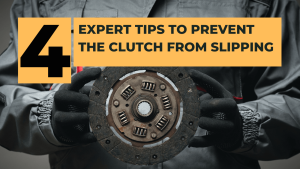
Given the clutch’s constant exposure to friction, it is not surprising that it will eventually wear out. The time your car lasts before the clutch needs a replacement would depend on how you drive it. Your clutch might last 10,000 miles before you need to replace it, or it might last 150,000 miles before giving out. Here are some tips for adjusting your driving style to safeguard your clutch and finances.
1. Don’t ride the clutch
Driving instructors frequently use the phrase “riding the clutch,” but it’s not always entirely obvious what it refers to or why it could damage your vehicle. Simply keeping the clutch pedal slightly depressed is known as “riding the clutch.” With only partial engagement, this presses the pressure pad on the clutch plate, increasing friction and hastening clutch wear. Keep your foot well away from the clutch unless you are shifting gear to prevent this from happening. Avoid using a semi-depressed clutch when turning corners or slowing down for traffic lights.
2. Change gear quickly
As you shift gears, move quickly. This is a common issue for novice drivers when learning to operate a manual car for the first time. There is no need for a lengthy delay when shifting gears, but the longer the clutch pedal is down, the more pressure is placed on the clutch each time. Even though it may only take a few seconds, consider how many times you change gear during an average drive, and you will soon understand how rapidly this can add up over time.
3. When you come to a complete stop, put your car in neutral
It can harm the clutch to wait at stop signs or intersections with the clutch depressed, first gear engaged, and the brake on. If you stop for any period, switching to neutral gear and applying the handbrake is preferable to keep your vehicle still.
4. Cylinder Leaking
If your car is new, a hydraulic clutch with both slave and master cylinders will be present. These cylinders are responsible for maintaining the fluid pressure needed when your vehicle engages or disengages. The correct fluid pressure also helps you maintain your speed while driving. These cylinders’ seals are subjected to extreme pressure and temperature changes, leading to leakage and cracking. Keep an eye out for these cylinder leak warning signals and perform a cylinder leak test more often to stop your clutch from slipping.
Not that we know what clutch slipping is, but it is essential to understand what one can do in the event of a clutch slipping.
What should I do if my clutch is slipping?
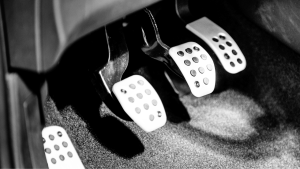
You should first drive more cautiously if your clutch is slipping. Reduce your overall speed and drive cautiously until you can get the clutch check out and fixed by a mechanic and reach the auto care shop. The one thing you must not do is avoid the problem and continue driving without solving the issue.
They can repair or replace the clutch or maybe just one of its parts that are causing the issue. Although it is unlikely, that if you avoid the problem for an extended period, the damage could get severe enough that you will need a brand-new clutch. You can fix a slipping clutch and prevent it from happening with any of the following techniques:
-
Clutch Replacement
Whether your car has FWD or RWD drivetrain will determine how difficult a clutch replacement is. Clutch replacement is much more challenging on FWD because the engine the mechanic needs to first remove the engine, hoist it up, and then lower the transaxle to replace a clutch. That means more labour and equipment, which will raise the price of a clutch replacement.
-
Flywheel resurfacing or replacement
The flywheel may require resurfacing or replacement if it has become contaminated with oil, has developed warping grooves, or has become discoloured due to heat. The high temperatures and metal-to-metal contact will likely damage the flywheel if the clutch is worn down to the rivets and needs replacement.
-
Changing the throwaway bearing
Any level of clutch repair will probably require this step because before you add any new parts to your clutch, it will require a new bearing.
-
Pilot bushing inspection
If your vehicle has a slipping clutch and a high mileage, replacing the bushing may be necessary for the clutch repair. The bushing is situated close to the crankshaft.
Conclusion
You won’t be able to start your car without a clutch. If you notice symptoms of a slipping clutch, it is better not to drive.
There is nothing you can do to stop the clutch from deteriorating. You may notice some symptoms of a slipping clutch and decide what to do in that case. Exercise caution while driving and abstaining from bad habits like riding the clutch, and generally not overworking it will help you reduce the harm. Additionally, it would help if you kept your clutch well-maintained.
You should not be afraid if you’ve just realized that your clutch is slipping. Technically, you can continue driving with a slipping clutch for hours, days, or weeks, but you shouldn’t. You never know when the slipping clutch could lead to a total clutch failure.
Any minor mechanical issue with a vehicle is simple and inexpensive to fix. Drive slowly and take your car to any nearby service center where you can get a car clutch repair. Even if a minor problem doesn’t seem urgent, you should have it fixed as soon as possible when it first appears in any part of your car. Still, if you don’t take care of it, eventually it will grow much larger and more expensive.

